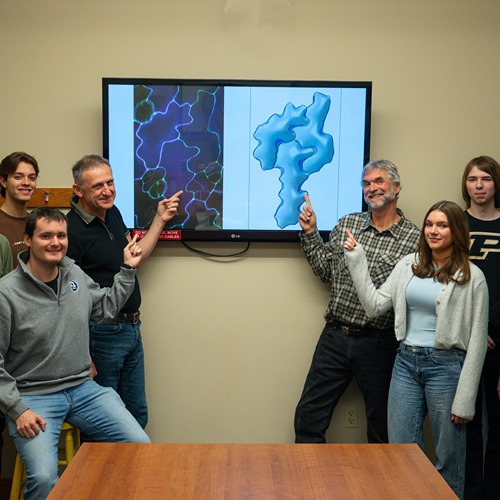Unexpected Plants and Animals of Indiana: Ring-necked Pheasant
In 1962’s “The Annotated Mother Goose,” author William S. Baring-Gould theorized the five golden rings included in “The 12 Days of Christmas” refer not to jewelry, but Ring-necked Pheasants. Whether his theory matches the English Christmas carol’s original meaning or not, pheasants have secured their place in the holiday season for families across rural America.
“My family has gone on an annual pheasant hunting trip in northern Indiana every November for more than 60 years. I’ve been lucky enough to join them the past 16 seasons,” said Extension wildlife specialist Jarred Brooke.
“It was that relationship to the hunt and to Ring-necked Pheasants that launched my career in conservation. They are why I am sitting here today. I enjoyed it so much that I wanted to figure out a way I could make wildlife my career.”
The passion led Brooke to Purdue where he studied wildlife science, graduating in 2012 and returning in 2016 to work in Extension.

“Ring-necked Pheasants are a complicated bird,” Brooke explained. “They are not native to the United States, yet they have permeated the culture of rural America and spawned a large conservation movement.”
Hoosier pheasants are of Chinese descent. Among the earliest records of pheasants in America are those released by George Washington at Mount Vernon during his presidency. In 1881, Ring-necked Pheasants were released in Oregon, marking the beginning of their permanent habitation. Indiana began stocking pheasants as a hunting opportunity around 1900.
“Pheasants are often called farmland birds because they were closely associated with the agriculture in the past,” Brooke explained. “The small farms of 50 years ago provided a great home with waste grain, weedy fields, idle areas and fencerows. Indiana’s pheasant population peaked in the 1960s but declined with habitat loss as farms evolved.
“Farm fields are larger now leaving less acreage for fence rows and idle areas, which in turn leaves less room for pheasant habitat. In farm country today, you are most likely to find wild pheasants in field borders or other areas that have been converted to native grasses and wildflowers through programs like the Conservation Reserve Program (CRP).”
In response to plummeting populations, pheasant supporters created a conservation movement.
“Pheasants Forever has roughly 140,000 members, including myself,” said Brooke. “They voluntarily contribute their time and money to conserve habitat for the pheasants. It has trickle-down benefits for other wildlife species including pollinators, other birds and deer.”
Many agricultural producers also voluntarily enroll their property in conservation programs like CRP in hopes of bolstering pheasant and other wildlife populations.
When asked why he and others are drawn to pheasants, Brooke had no difficulty responding.
“Pheasants are attractive for a variety of reasons. The males have beautiful iridescent feathers. They also provide a challenging, but social hunting opportunity where you get to connect with family and friends and have the chance to watch good hunting dogs do what comes natural. And of course, pheasants are excellent table fare.”
Pheasants are gallinaceous birds, closely related to turkeys and chickens. “Their meat is similar to domestic poultry except their legs are a bit tougher since they live their life on the run,” noted Brooke.
When evading predators, pheasants prefer to run, but can fly short distances at speeds more than 40 miles per hour.
Today, most of Indiana’s pheasants live in northwest counties including Jasper, Benton and Newton where you find agricultural fields mixed with permanent cover like native prairie and CRP fields. Pheasants can also be found close to campus in Tippecanoe County, though they are more common out west in states like South Dakota where the Ring-necked Pheasant is the state bird.
“In those areas, you’ll see their impact this time of year,” said Brooke. Pheasants are cooked for family dinners, their feathers are displayed as ornaments on Christmas trees and, possibly, their ringed necks are mentioned in song.







